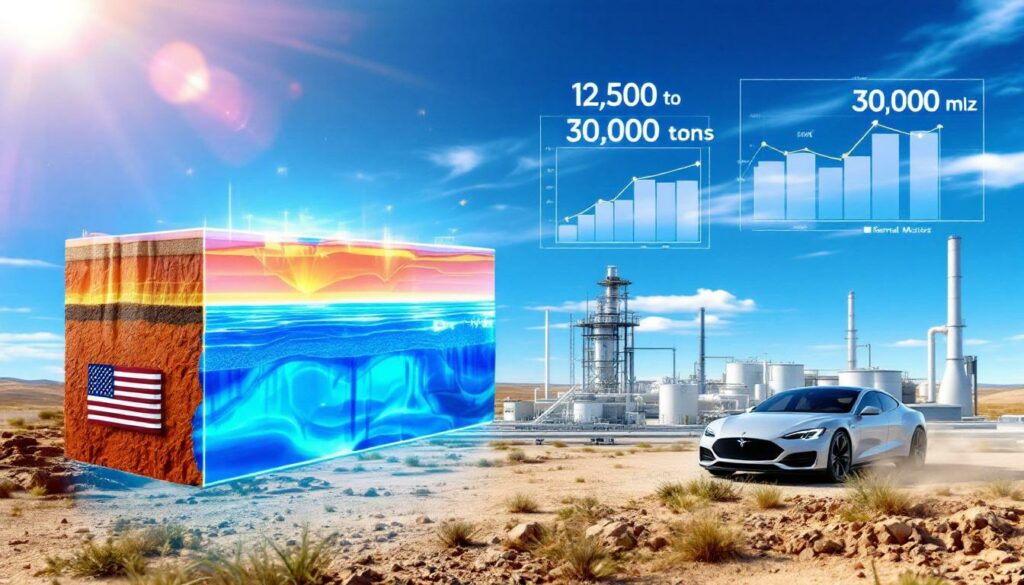Understanding the US Smackover Formation: America's Lithium Frontier
The United States is sitting on a lithium goldmine that few Americans have heard of. Stretching across multiple southern states from Florida to Texas, the Smackover Formation represents one of North America's most promising lithium resources, with estimated reserves exceeding 4 million metric tons. This ancient geological formation, formed approximately 150 million years ago during the Jurassic period, contains lithium-rich brine deposits that could revolutionize domestic battery material production.
Unlike the salt flats of South America or hard-rock mines of Australia, the Smackover's lithium is dissolved in underground brine reservoirs at concentrations ranging from 150-500 parts per million—significantly higher than many competing resources globally. These brines lie approximately 9,000 feet below the surface in porous carbonate rock formations.
"The Smackover represents a unique opportunity for domestic lithium production," notes geologist Dr. Rebecca Chen of the Arkansas Geological Survey. "Its concentration levels and accessibility make it particularly valuable for commercial extraction."
Strategic Importance for US Lithium Supply Chain
The strategic value of developing Smackover lithium cannot be overstated. Currently, the United States imports approximately 95% of its lithium supply, creating vulnerability in the critical minerals energy transition necessary for energy transition technologies.
According to USGS estimates, each electric vehicle requires approximately 8-10 kg of lithium. With the Smackover's potential 4 million metric tons, this resource could theoretically support the production of over 400 million electric vehicles—more than double the total number of passenger vehicles currently registered in the United States.
Developing this resource aligns perfectly with several federal initiatives:
- The Inflation Reduction Act's domestic content requirements
- The Defense Production Act's critical minerals provisions
- The Bipartisan Infrastructure Law's battery manufacturing incentives
"Lithium independence is as strategically important to America's future as energy independence was in previous decades," explains energy policy analyst Maria Gonzalez. "The Smackover represents our best chance to achieve this critical objective."
How EnergyX Expanded its Lithium Holdings in the Smackover
EnergyX has positioned itself as a key player in developing Smackover lithium through strategic acquisitions. In July 2025, the company announced its purchase of Pantera Lithium's 35,000-acre holdings in southern Arkansas in a deal valued at A$40 million (approximately $26.1 million USD).
The transaction structure reveals EnergyX's confidence in future lithium development:
- A$6 million cash payment upfront
- 2.3 million EnergyX shares valued at A$14.50 ($9.47) each
- Completion expected by late 2025
This acquisition significantly expands EnergyX's footprint in the region, bringing their total Smackover holdings to approximately 47,500 acres—creating one of the largest lithium development portfolios in the southeastern United States.
Strategic Positioning in the Competitive Landscape
EnergyX isn't alone in recognizing the Smackover's potential. The formation has attracted significant interest from both established energy companies and lithium specialists:
| Company | Approximate Acreage | Development Status |
|---|---|---|
| Chevron | 60,000+ | Exploratory drilling |
| Exxon Mobil | 120,000+ | Pilot extraction facility |
| Albemarle | 25,000 | Resource assessment |
| Standard Lithium | 150,000 | Advanced pilot project |
| EnergyX | 47,500 | Resource assessment |
The entry of major oil companies into lithium development signals a significant shift in energy strategy. With decades of experience in brine extraction technologies from oil operations, companies like Exxon and Chevron bring valuable expertise to lithium development.
"This acquisition transforms Pantera into a significant minority shareholder in EnergyX," notes mining industry evolution analyst James Peterson. "It represents a consolidation trend we're seeing across the Smackover region as companies prepare for commercial production."
The deal comes after EnergyX's unsuccessful attempt to acquire Galan Lithium's Argentina assets in 2024, indicating the company's pivot toward focusing on North American resources.
What Production Goals Has EnergyX Set for its Smackover Operations?
EnergyX has outlined ambitious production targets for its Smackover operations. According to company announcements, they aim to achieve:
- 12,500 metric tons of lithium carbonate equivalent (LCE) annually by 2028
- Expansion to 30,000 metric tons of LCE per year by 2030
These goals are particularly significant considering that current US domestic lithium production is limited to a single operation—Albemarle's Silver Peak mine in Nevada—which produces approximately 5,000 metric tons annually. EnergyX's production goals would effectively multiply domestic lithium output by several times.
Technical Challenges and Solutions
Achieving these production targets requires overcoming significant technical challenges. The primary innovation driving EnergyX's strategy is direct lithium extraction technology—a revolutionary approach that differs dramatically from traditional evaporation pond methods used in South America.
DLE offers several advantages over conventional lithium extraction:
-
Reduced environmental footprint:
- Up to 90% less water usage than evaporation ponds
- Minimal land disturbance compared to open-pit mining
- Lower carbon emissions per ton of lithium produced
-
Accelerated production timeline:
- Hours-to-days processing time versus 18+ months for evaporation ponds
- Consistent production regardless of weather conditions
-
Higher recovery rates:
- Potential to extract 90%+ of available lithium versus 40-50% for evaporation
- More complete resource utilization
However, DLE technologies remain largely unproven at commercial scale, particularly in the Smackover formation's specific brine chemistry. The high magnesium-to-lithium ratios and presence of other elements like bromine create unique processing challenges.
"The key technical hurdle is selective lithium extraction while managing interference from other ions," explains Dr. Elena Rodriguez, a lithium processing specialist. "EnergyX's proprietary LiTAS™ technology shows promise, but scaling from laboratory to commercial production introduces many variables."
How Does General Motors Factor into EnergyX's Strategy?
General Motors has emerged as a key strategic partner in EnergyX's lithium development plans. In 2023, GM backed EnergyX by purchasing lithium-rich acreage in a $50 million financing round, securing a right of first refusal arrangement for lithium offtake from the company's projects.
This partnership exemplifies the automotive industry's growing strategy of vertical integration in battery supply chains. For GM, securing direct access to lithium supports their ambitious electric vehicle plans, which include:
- Launching 30 EV models globally by 2025
- Achieving annual production capacity of 1 million EVs in North America by 2025
- Transitioning to an all-electric vehicle portfolio by 2035
"Automakers are recognizing that battery material supply security is as important as manufacturing capacity," notes automotive industry analyst Sarah Johnson. "GM's investment in EnergyX represents a forward-looking hedge against supply constraints and price volatility."
Vertical Integration Benefits
This partnership creates mutual benefits for both companies:
For EnergyX:
- Secured future revenue stream through offtake agreements
- Validation from a major industrial partner
- Potential access to GM's extensive logistics and industrial expertise
- Enhanced credibility for future financing rounds
For General Motors:
- Priority access to domestically-produced lithium
- Potential cost advantages from direct supplier relationship
- IRA tax credit qualification through domestic content
- Reduced exposure to lithium price volatility
- Supply chain transparency and ESG compliance
This relationship follows similar moves by other automakers, including Ford's investment in Liontown Resources and Tesla's agreements with Piedmont Lithium, though GM's involvement with EnergyX represents one of the more substantial financial commitments in the sector.
What Regulatory and Financial Considerations Impact the Project?
The development of Smackover lithium faces several unique regulatory challenges, particularly regarding royalty structures in Arkansas, where much of the resource is located.
Arkansas Lithium Royalty Framework
Unlike more established mining jurisdictions, Arkansas has only recently begun developing specific royalty frameworks for lithium extraction. Companies operating in the region must apply for state-specific lithium royalty rates, creating some regulatory uncertainty.
Recent precedents have been established through agreements with Exxon Mobil and Standard Lithium, though the specific rates remain confidential. Industry analysts estimate these rates fall between 3-5% of gross production value—comparable to other U.S. mineral extraction royalties.
The Arkansas Oil and Gas Commission and the Arkansas Department of Energy and Environment serve as the primary regulatory bodies overseeing lithium development in the Smackover region. Their involvement encompasses:
- Resource extraction permitting
- Environmental compliance monitoring
- Water usage approvals
- Land use authorization
- Royalty rate determination and collection
The economic impact for Arkansas could be substantial. Using conservative price projections of $15,000 per metric ton of lithium carbonate, EnergyX's planned 30,000-ton annual production could generate up to $22.5 million in annual state royalties at a 5% rate.
Investment and Valuation Perspectives
EnergyX's financial positioning within the battery metals investment sector presents both opportunities and challenges. As a privately-held company with significant international investment, including from Posco Holdings, EnergyX maintains flexibility in its development timeline.
Current valuation metrics for lithium projects have fluctuated significantly amid volatile lithium prices:
| Time Period | Average Lithium Carbonate Price | Typical Project Valuation Metrics |
|---|---|---|
| 2021-2022 Peak | $70,000+/ton | 15-20x projected EBITDA |
| 2023-2024 Correction | $14,000-25,000/ton | 8-12x projected EBITDA |
| 2025 Current | $20,000-30,000/ton | 10-15x projected EBITDA |
Industry analysts speculate about EnergyX's potential public listing, with estimates placing the company's pre-IPO valuation between $1-2 billion, though the company has not confirmed such plans.
"The lithium sector is experiencing a reset in valuations following the price correction of 2023-2024," explains financial analyst Robert Chang. "However, projects with clear paths to production in geopolitically stable jurisdictions continue to command premium valuations."
How Does the Smackover Project Fit into the Global Lithium Landscape?
EnergyX's Smackover development represents just one component of the company's global lithium strategy, which also includes significant projects in South America—particularly in northern Chile's Salar de Atacama region, home to some of the world's highest-grade lithium brines.
Comparison with International Lithium Projects
The Smackover project offers distinct advantages and challenges compared to international lithium sources:
Advantages:
- Proximity to U.S. battery and EV manufacturing
- Established infrastructure (roads, power, water)
- Politically stable jurisdiction
- Potential IRA tax credit qualification
- Reduced transportation carbon footprint
Challenges:
- Lower lithium concentration than Chilean salars
- Unproven commercial-scale technology
- Higher extraction costs than South American operations
- Complex brine chemistry requiring advanced processing
This diversified approach follows EnergyX's unsuccessful 2024 attempt to acquire Galan Lithium's Argentina assets, demonstrating the company's commitment to building a global lithium portfolio while prioritizing North American resources.
Market Impact Assessment
EnergyX's planned production would significantly impact global lithium markets. At full capacity of 30,000 tons annually by 2030, the Smackover project would represent approximately:
- 5-7% of projected 2030 global lithium supply
- 25-30% of projected U.S. lithium production
- Enough lithium to support production of 3-4 million electric vehicles annually
This production could help reduce China's dominance in lithium processing, which currently accounts for approximately 60% of global capacity. By establishing a complete domestic supply chain from extraction through refining, EnergyX and similar U.S. projects contribute to resource security in an increasingly competitive global environment.
"The geopolitical importance of establishing North American lithium supply cannot be overstated," notes defense analyst Col. James Henderson (ret.). "Battery materials have become as strategically vital as semiconductor manufacturing capacity."
What Are the Technical Innovations Required for Successful Extraction?
The successful development of Smackover lithium resources hinges on overcoming significant technical challenges through innovative approaches to extraction and processing.
Direct Lithium Extraction (DLE) Implementation Challenges
Direct Lithium Extraction represents a fundamental shift from traditional lithium production methods. Unlike the solar evaporation ponds that dominate South American production or the hard-rock mining prevalent in Australia, DLE technologies extract lithium directly from brine using selective adsorption materials or ion exchange resins.
Key technical considerations for Smackover DLE implementation include:
-
Brine chemistry management:
- Dealing with high magnesium-to-lithium ratios (15:1 to 40:1)
- Managing calcium and strontium that can cause scaling
- Addressing high total dissolved solids (TDS) levels of 150,000+ ppm
-
Selectivity optimization:
- Achieving high lithium recovery rates (targeting 90%+)
- Minimizing extraction of non-target elements
- Maintaining adsorbent performance over multiple cycles
-
Process integration:
- Coordinating extraction with brine reinjection
- Managing flow rates for optimal resource utilization
- Balancing extraction rates with processing capacity
The environmental advantages of DLE are substantial. According to Argonne National Laboratory research, DLE requires approximately 390 cubic meters of water per ton of lithium carbonate versus over 2,000 cubic meters for evaporation methods. Land disturbance is similarly reduced by 80-90%.
Processing and Refining Infrastructure
EnergyX's planned Texas refinery represents a critical component of their integrated strategy. The facility will convert lithium chloride solution from the Smackover operations into battery-grade lithium products including:
- Lithium carbonate (Li₂CO₃)
- Lithium hydroxide monohydrate (LiOH·H₂O)
- Potentially lithium metal for next-generation batteries
The refinery location offers strategic advantages:
- Proximity to extraction operations (reducing transportation costs)
- Access to rail and port infrastructure for product distribution
- Available skilled chemical processing workforce
- Competitive electricity rates
- Favorable business environment
Quality specifications for battery-grade lithium are exceptionally demanding, requiring:
- 99.5%+ purity for lithium carbonate
- 99.9%+ purity for lithium hydroxide
- Strict limits on impurities including sodium, magnesium, calcium, and iron
"The jump from pilot to commercial scale introduces significant engineering challenges," explains chemical engineer Dr. Thomas Williams. "Process design must account for variations in brine chemistry, equipment scaling factors, and continuous operation requirements that aren't evident at smaller scales."
FAQ About EnergyX's Smackover Lithium Project
What makes the Smackover formation uniquely valuable for lithium extraction?
The Smackover formation's value derives from several key characteristics:
- Concentration levels: Brines contain 150-500 ppm lithium, competitive with many global resources
- Resource size: Estimated >4 million metric tons of recoverable lithium
- Infrastructure advantages: Existing roads, power, water, and skilled workforce
- Proximity to end-users: Reduced transportation to U.S. battery manufacturers
- Geological stability: Well-understood formation with decades of oil industry data
- Year-round production potential: Unlike evaporation ponds, not weather-dependent
Additionally, the formation's carbonate host rock provides natural filtration, resulting in brines with fewer suspended solids than many competing resources.
How does Direct Lithium Extraction technology work?
Direct Lithium Extraction encompasses several related technologies that selectively capture lithium ions from brine solutions without requiring evaporation:
-
Adsorption-based DLE: Uses specialized materials (often lithium titanates or manganese oxides) that preferentially adsorb lithium ions from solution
-
Ion exchange DLE: Employs resins with functional groups that selectively capture lithium through ion exchange mechanisms
-
Solvent extraction DLE: Utilizes specific solvents that selectively transfer lithium ions from aqueous to organic phase
The typical DLE process follows these steps:
- Brine is pumped from underground reservoirs
- Pre-treatment removes interfering elements
- The brine contacts the selective lithium extraction material
Ready to Invest in America's Emerging Lithium Frontier?
Discover how significant mineral discoveries like the Smackover Formation can transform investment portfolios by exploring Discovery Alert's dedicated discoveries page, powered by our proprietary Discovery IQ model that turns complex geological data into actionable insights. Begin your 30-day free trial today at https://discoveryalert.com.au/discoveries/ to receive instant notifications on emerging opportunities in the resource sector.




